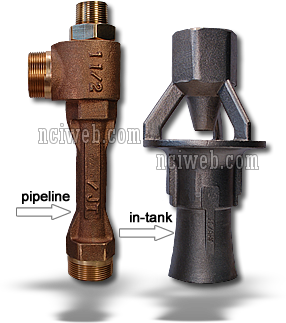 Jet Pumps and Tank Eductors
Jet Pumps and Tank Eductors
We invite you to explore the possibilities of jet pumps and tank eductors use in your operation. You might be surprised at the many ways jet pumps can help improve your company’s profitability!
Providing a practical alternative to more complicated and expensive methods, jet pumps offer simple, more cost-effective ways to pump, mix or heat a wide range of liquids and gases used in the process industry. Jet pumps can operate with a wide variety of motive liquids and gases.
Jet pumps have a myriad of uses. Jet pumps not only pump liquids, they can also heat, mix and blend either in-line or in-tank. Jet pumps can evacuate gases, create a vacuum, boost suction pressures, mix granular solids with liquids and move granular solids with compressed air. In fact, you will be surprised at what a jet pump can do to solve your problem.
While jet pumps and eductors may differ in appearance, basic operation is the same. Jet pumps, also known as eductors, operate on the principles of fluid dynamics. An operating fluid media, which is referred to as the MOTIVE, placed under pressure enters the inlet and is forced through the nozzle where it is converted into a high-velocity stream. This high-velocity stream decreases the pressure in the suction chamber, creating a partial vacuum that draws the suction material into the chamber where it is entrained by the motive media. Once the SUCTION stream is drawn in, shear between motive media and the transported material causes both media to be intermixed and pumped out the DISCHARGE outlet, dispelled at a pressure greater than that of the SUCTION stream but lower than that of the MOTIVE. This basic principle of fluid dynamics is what makes jet pumps work.
[/vc_column_text][vc_row_inner][vc_column_inner width=”1/2″][vc_column_text]Tank Eductors
The motive fluid for tank eductors may come from two sources. The tank liquid may be recirculated through the eductor via an external pump or a secondary fluid may be introduced into the tank. Gases, as well as liquids, are used as the secondary fluid. Aeration and gas dispersion for chemical reactions are common uses of gas motive systems. Liquids are typically additives to be mixed with or to dilute the tank contents. Tank eductors are often used in heating applications where the motive fluid is generally steam. When used for heating they are often referred to as sparger nozzles.
Computer optimized flow paths enable the tank eductor to maintain a high “pick-up ratio” (the ratio of fluid entrained to the motive fluid) while maximizing the hydraulic efficiency (the ratio of hydraulic power at the outlet of the tank eductor to the hydraulic power at the inlet) to generate an optimum flow field from the greatest flow amplification. Optimum flow field enables more activity within the tank than competitive units without changing pumps.[/vc_column_text][/vc_column_inner][vc_column_inner width=”1/2″][vc_column_text]
Jet Pumps
Jet Pumps are a kind of jet-type pump that do not require any moving parts to be able to pump out a liquid or gas from a certain area. Jet pumps are used inline and make use of their structure to transfer energy from one fluid to another via the Venturi effect. The structure of the pump is such that it has an injector chamber with a narrow shaped nozzle or tapered jet that is located inside the chamber and points axially towards the exhaust chamber to increase the pressure of the motive fluid as it enters the jet pump.
At the bottom of this nozzle is an opening that is used to suck in any form of fluid or other substance that needs to be extracted from a certain environment. The suction happens due to Venturi effect that creates a drop in pressure at the tip of the nozzle due to the fast flowing motive fluid which has gained kinetic energy due to the tapered shape of the nozzle. This difference in pressure causes the desired fluid to be sucked into the jet pump and mixed into the flow stream to be guided out of the jet pump.
.[/vc_column_text][/vc_column_inner][/vc_row_inner][/vc_column][/vc_row]
